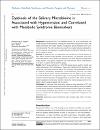Dysbiosis of the Salivary Microbiome is Associated with Hypertension and Correlated with Metabolic Syndrome Biomarkers
| Author | Sohail, Muhammad U |
| Author | Hedin, Lars |
| Author | Al-Asmakh, Maha |
| Available date | 2021-11-29T10:51:18Z |
| Publication Date | 2021-11-25 |
| Publication Name | Diabetes, Metabolic Syndrome and Obesity: Targets and Therapy |
| Identifier | http://dx.doi.org/10.2147/DMSO.S325073 |
| Citation | Sohail MU, Hedin L, Al-Asmakh M. Dysbiosis of the Salivary Microbiome is Associated with Hypertension and Correlated with Metabolic Syndrome Biomarkers. Diabetes Metab Syndr Obes. 2021;14:4641-4653 https://doi.org/10.2147/DMSO.S325073 |
| Abstract | Background: Hypertension (HT) is an idiopathic disease with severe complications and a high incidence of global mortality. Although the disease shares characteristic features with diabetes and obesity, the complex interplay of endogenous and environmental factors is not well characterized. The oral microbiome has recently been studied to better understand the role of commensal microorganisms in metabolic disorders, including HT, although its role in disease etiology is unclear. Methods: To bridge this gap, we compared the oral microbiome and clinical chemistry of adult subjects enrolled at Qatar Biobank. Clinical chemistry was performed using Roche Cobas-6000 analyzer. Saliva samples were subjected to 16S rRNA sequencing using Illumina MiSeq platform. Cross-gender comparisons were made between control (males/females) (C-M and C-F) and HT (HT-M and HT-F) groups. Results: The HT groups had higher (p ≤ 0.05) BMI, plasma glucose, insulin, C-peptide, and alkaline phosphatase (ALP) concentrations. Triglycerides, cholesterol, LDL-cholesterol, and sodium ions were similar among the groups. The microbiome was predominantly occupied by Firmicutes, Bacteroidetes, Proteobacteria, and Actinobacteria. Firmicutes were higher (p ≤ 0.05) in the HT groups, whereas Proteobacteria was only higher in the C-F group. Prevotella and Veillonella were significantly higher in the HT groups and exhibited a positive correlation with blood pressure and hyperglycemia. In contrast to other studies, the mathematical summation of priori-select microbes reveals that nitrate-reducing microbes were higher in the HT groups compared with the controls. Conclusion: In conclusion, these observations suggest a strong association of HT with microbial dysbiosis, where microbial species other than nitrate-reducing microbes contribute to blood pressure regulation. The findings affirm plausible microbial signatures of hypertension and suggest manipulating these microbes as a novel treatment modality. Future experiments are warranted for the mechanistic investigation of hypertension metagenomics and microbial activity. |
| Sponsor | Open access funding is provided by the Qatar National Library. This work was sponsored by Qatar National Research Fund (UREP24-103-3-038) and Qatar University (QUCP‐CHS‐2019‐1) |
| Language | en |
| Publisher | Dovepress |
| Subject | hypertension salivary microbiome Qatar Biobank lipid profile Prevotella Veillonella |
| Type | Article |
| Volume Number | 14 |
Files in this item
This item appears in the following Collection(s)
-
Biomedical Research Center Research [669 items ]
-
Biomedical Sciences [652 items ]


